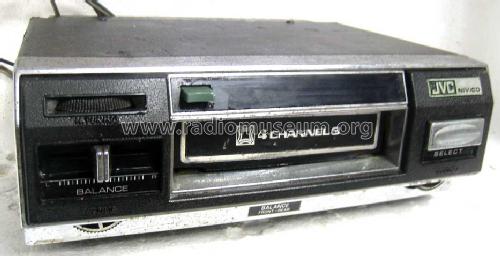Nivico 4 Channel 8 Track Car Player 1350E
JVC - Victor Company of Japan, Ltd.; Tokyo
- Paese
- Giappone
- Produttore / Marca
- JVC - Victor Company of Japan, Ltd.; Tokyo
- Anno
- 1970 ??
- Categoria
- Registratore audio/video e/o riproduttore
- Radiomuseum.org ID
- 204528
- Principio generale
- Amplificatore audio
- Gamme d'onda
- - senza
- Particolarità
- Nastro o cassetta, formato speciale
- Tensioni di funzionamento
- Batteria di accumulatori, per tutto (es. autoradio, radio amatoriali) / 12 Volt
- Altoparlante
- - Questo apparecchio richiede altoparlante/i esterno/i.
- Materiali
- Plastica (non bachelite o catalina)
- Radiomuseum.org
- Modello: Nivico 4 Channel 8 Track Car Player 1350E - JVC - Victor Company of Japan,
- Forma
- Chassis o in scatola da montaggio
- Annotazioni
- 8 Track Stereo Record chassis for cars - Cartridge Tape Player. Wikipedia (Oct 2011): "Stereo 8, commonly known as the eight-track cartridge, eight-track tape, or simply eight-track, is a magnetic tape sound recording technology. It was popular in the United States from the mid-1960s through the late 1970s, but was relatively unknown in many European countries. Stereo 8 was created in 1964 by a consortium led by Bill Lear of Lear Jet Corporation, along with Ampex, Ford Motor Company, General Motors, Motorola, and RCA Victor Records (RCA). It was a further development of the similar Stereo-Pak four-track cartridge created by Earl "Madman" Muntz. A later quadraphonic version of the format was announced by RCA in April 1970 and first known as Quad-8, then later changed to just Q8. History: The original format for magnetic tape sound reproduction was reel-to-reel audio tape recording, first made widely available in the late 1940s. However, threading tape into the recorders was more difficult than simply putting a disc onto a phonograph player. Manufacturers introduced a succession of cartridges which held the tape inside a metal or plastic housing to eliminate handling. The first was RCA, which in 1958 introduced a cartridge system called Sound Tape or Magazine Cartridge Loading, but until the introduction of the Compact Cassette in 1963 and Stereo 8 in 1965, none was very successful.
The endless loop tape cartridge was first designed in 1952 by Bernard Cousino around a single reel carrying a continuous loop of standard 1/4-inch, plastic, oxide-coated recording tape running at 3.75 in.(9.5 cm) per second. Program starts and stops were signaled by a one-inch-long metal foil that activates the track-change sensor. (Bill Lear had tried to create an endless-loop wire recorder in the 1940s, but gave up in 1946, even though endless-loop 8 mm film cartridges were already in use for him to copy from. He would be inspired by Earl Muntz's four-track design in the early 1960s.)
Inventor George Eash, also from Toledo, invented a cartridge design in 1954, called the Fidelipac. The Eash cartridge was later licensed by manufacturers, notably the Collins Radio Corporation, which first introduced a cartridge system for broadcasting at the National Association of Broadcasters 1959 annual show. Fidelipac cartridges (nicknamed "carts" by DJs and radio engineers) were used by many radio stations for commercials, jingles, and other short items right up until the late 1990s when digital media took over. ...
There were several attempts to sell music systems for cars, beginning with the Chrysler "Hiway hi-fi" of the late 1950s (which used discs). Entrepreneur Earl "Madman" Muntz of Los Angeles, California, however, saw a potential in these "broadcast carts" for an automobile music system. In 1962 he introduced his Stereo-Pak four-track cartridge stereo system (two programs, each consisting of two tracks) and tapes, mostly in California and Florida. He licensed popular music albums from the major record companies and duplicated them on these four-track cartridges, or "CARtridges", as they were first advertised.
The popularity of both four-track and eight-track cartridges grew from the booming automobile industry. In September 1965, Ford Motor Company introduced factory-installed and dealer-installed eight-track tape players as an option on three of its 1966 models (Mustang, Thunderbird and Lincoln), and RCA Victor introduced 175 Stereo-8 Cartridges from its RCA Victor & RCA Camden artist's catalogs.[1] By the 1967 model year, all of Ford's vehicles offered this tape player upgrade option. Thanks to Ford's backing, the eight-track format quickly won out over the four-track format, with Muntz abandoning it completely by late 1970."
- Fonte esterna dei dati
- Guest Jeff Jeff, Perth, Australia
- Autore
- Modello inviato da Ernst Erb. Utilizzare "Proponi modifica" per inviare ulteriori dati.
- Altri modelli
-
In questo link sono elencati 999 modelli, di cui 882 con immagini e 147 con schemi.
Elenco delle radio e altri apparecchi della JVC - Victor Company of Japan, Ltd.; Tokyo


